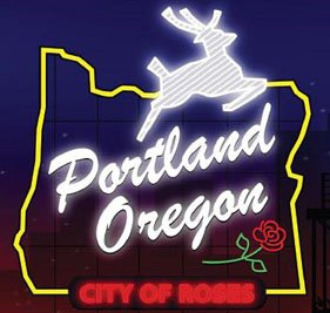
“Remember
the 90’s? You know, when people were talking about getting piercings and tribal
tattoos, saving the planet…forming bands? Well, there’s a place where that idea
still exists as a reality, and I’ve been there”. In the opening scenes of Portlandia Jason, a mid 20’s LA native
returns from a trip to Portland, only to realize that ‘The dream of the 90’s is
alive in Portland’, “Farm” (Originally aired January 21, 2011). The show’s
creators Fred Armisen, a former SNL cast member, and Carrie Brownstein, a past member
of a native Portland band, are also the stars in this hit sketch comedy. Portlandia pokes fun at the ever-fascinating
city of Portland through its goofy and exaggerated portrayals of the city’s
obsession with their original, local culture. With the embellished sketch’s of
waiting in day-long brunch lines, obsessing over the locality of food, and the
laid back hipster lifestyle, Portlandia might
not be such an overstatement of what life is really like for hipsters in
Portland.
Through
a mix of improvisation and scripted sketches, Fred and Carrie play the roles of
various characters that embody the ‘hipster’ trends and lifestyle in Portland.
While at a restaurant in the show’s first episode “Farm” (Originally aired January
21, 2011), the characters show their concern for the origin of the chicken and
heavily question the waitress about whether it is USDA organic, Oregon organic,
or Portland organic. They go even further to question her about the social
habits of the chicken on the farm, his personality, and his name, which we find
out, is Colin. Although the sketch is intentionally obnoxious and over the top
about the ‘locality’ of the food, this clip is not so far off from the true
habits of Portland residents. The obsession with local food products is so
engrained in the city’s culture that they have an entire website dedicated just
to finding them. The website is called portlandlocalfood.wordpress.com and
gives information about where to find everything from coffee, produce, and
meats, to clothing. The city is also known for its abnormally high
concentration of farmers markets and food coops that support local farming. You
can find these on just about every corner, whereas chain grocery stores are a
rarity.

Fred
and Carrie’s comedic scene with the waitress pokes fun at this local
phenomenon, but the idea is deeply rooted in hipster culture. In a discussion
about hipster identity, Henke (2013) explains that hipsters are anti-capitalist
and heavily believe in local consumption. They diverge from popular culture
with a longing for individuality within subculture as a way of expressing their
authenticity. This authenticity allows hipsters like Carrie and Fred to stay
true to local, natural product, and to ensure they are not consuming mass-produced
chicken from grower houses. The city prides itself on its artisan heavy economy
that promotes local circulation of wealth to reinvest in its social
infrastructure and care for the environment. It also puts an emphasis on the quality
of products over quantity (Heying, 2010). On a recent visit to the city myself,
I couldn’t help but laugh at the amount of ‘local’ signs on every restaurant
menu and grocery store sign. Although usually vacant, even large chain grocery
stores like ‘Safeway’ are infested with yellow tags in every isle on all things
that are ‘local’.
It
is evident that the quirky characters Fred and Carrie portray have a serious fear
of conforming to pop culture and mass media ideals, as they do transnational corporations.
In “Take Back MTV” (Originally aired January 4, 2013), Spike is a 30-year-old,
unemployed, washed up punk who is outraged with the new age ‘garbage’ that MTV
has become. He misses the old MTV where cool young bands were able to advertise
themselves when there was no such thing as the repetitive, ‘poppy’ top 20.
Spike gets Iris (Carrie) on board and enlists the help of former MTV producers
and VJs to go to New York City to take back MTV. This episode represents the real life opposition of hipsters
to pop culture in Portland and around the country. Spike and Iris’s orientation
makes them cynical of the lack of authenticity and originality in pop music
today. In The Hipster Handbook,
author Robert Lanham (2003) explains that hipsters have a fear of the
mainstream, and tend to listen to bands from independent labels. This trend may
be related to the fact that today’s late 20 year olds were brought up in the
old school MTV generation. The channel was historically known for its
innovative and authentic musical taste that gave lesser-known artists a chance
at fame. Today, it is overloaded with somewhat trashy reality show programming
and has little focus on music.

Spike
and Iris show a true passion for independent labels, which again shadows their
against the grain, hipster attitudes. After all, underground bands run the
music scene in the city. Lanham (2003) also writes that this culture equally
weights the sound of music with the perceived authenticity of the artist when
choosing what to listen to. The show truly reflects the reality of music in
Portland. Livibility.com even ranked Portland as the number three city with the
best music scene due to its heavy concentration of vintage venues, independent
record stores, and local musicians (Krough, 2012).
This
trend of local authentic music is a reoccurring theme in Portlandia. In “Squiggleman” (Originally aired January 18, 2013),
helicopter parents Brendan and Michelle create a children’s band due to the
poor quality of music available in their son’s school library. They and other
hipster parent’s share the belief that they don’t want their kids listening to
mainstream garbage, and as a result play child versions of their favorite
underground music. This aligns with the reality of the city’s preference of subculture.
The parents in the episode show pride in their unique taste and don’t want their
children being influenced by mass media.
In
Portlandia regardless of the sketch,
the characters always seem to be hung up on some small detail that is the focus
of each episode. Whether it be the origin of the chicken, decorating everything
in sight with birds and calling it art, pickling just about everything, or
devising a life-plan to success using spread sheets to get a kid into
pre-school, the characters seem to have more time in their day than ever
imaginable. The storylines also tend to be drawn out where the characters
somehow never accomplish anything.

In
the opening scenes of the show, Jason explains to Donnie, “Portland is the city
where young people go to retire”, “Farm” (Originally aired January 21, 2011).
He talks about how people are content being unambitious and only working a
couple hours a week in places like coffee shops. Although partly exaggerated
like everything else on the show, Portlandia
portrays this common way of life where there are no rules; a place where
time off without work is considered virtuous. The goal is to have a creative
career to escape from the 9-5 commitment of the corporate world. This way of
life is seemingly unrealistic to so many, but hipsters in Portland somehow make
it work. Portlandia has been
criticized for this, but they didn’t make the idea up. New York Times writer
Jon Caramanica notes that the show never explicitly says the word ‘slacker’ or
‘lazy’ but it is implied by the story lines and obscene amounts of free time in
the characters lives. Even the show’s theme song, “Feel It All Around” is a
laid back, slow beat song that mocks the speed of molasses (Caramanica, 2011).
This
non-traditional way of life for young hipsters is also shown in “One Moore
Episode” (Originally aired on January 13, 2012). Fred and Carrie get so
addicted to a box set of Battlestar Galactica that they neglect all
responsibilities and lose their jobs due to their ridiculous addiction. Their
lack of concern about doing absolutely nothing productive for days is just one
comedic representation of this carefree and seemingly backwards mindset that is
considered atypical for young Americans who should be establishing careers.
 The
outlandish taste is music, lifestyle, and clothing make Portlandia seem too strange and funny to be true. The goofy
portrayal comes off as awkward, but the hipster culture today is actually
praised for its creativity and individuality away from mainstream norms. Scholars
Zeynep & Thompson (2012) discuss how hipsters customize and create their
possessions and style to ensure that they are one of a kind. To hipsters, this
style is known as ‘kitchy’, and means that weirdness is conscious and
intentional to express the owner’s ironic motives for why they purchased an
item. Someone who is ‘kitsch’ purposefully displays themselves as different
with the awareness that they are against the norm (Henke, 2013). This is
continually displayed all over the show, as the characters in each sketch
express different kitchy styles. Ranging from vintage wildlife or tie-dye
t-shirts, ripped leather jackets, Indian serapes, and an array of unusual
mismatched thrift shop clothing, there is nothing mainstream about the hipster
appearance in Portland. When in the city recently, I almost felt that it was an
ongoing competition for who could dress more outrageous.
The
outlandish taste is music, lifestyle, and clothing make Portlandia seem too strange and funny to be true. The goofy
portrayal comes off as awkward, but the hipster culture today is actually
praised for its creativity and individuality away from mainstream norms. Scholars
Zeynep & Thompson (2012) discuss how hipsters customize and create their
possessions and style to ensure that they are one of a kind. To hipsters, this
style is known as ‘kitchy’, and means that weirdness is conscious and
intentional to express the owner’s ironic motives for why they purchased an
item. Someone who is ‘kitsch’ purposefully displays themselves as different
with the awareness that they are against the norm (Henke, 2013). This is
continually displayed all over the show, as the characters in each sketch
express different kitchy styles. Ranging from vintage wildlife or tie-dye
t-shirts, ripped leather jackets, Indian serapes, and an array of unusual
mismatched thrift shop clothing, there is nothing mainstream about the hipster
appearance in Portland. When in the city recently, I almost felt that it was an
ongoing competition for who could dress more outrageous.
Portlandia’s satirical spoof of the unique city may exaggerate some aspects of
the hipster identity, but when visiting the city first hand, their portrayal of
this distinct lifestyle is pretty spot on. With their anti-capitalist mentality
that rejects cooperate domination and mainstream norms; the hipster culture in
Portland gives special attention to detail in just about all aspects of life.
From the food they eat, music they listen to, stores they shop in, shows they
watch, and clothes they wear, Portlandia
depicts what seems an unrealistic lifestyle, however we have to remember, ‘the
dream of the 90’s is alive in Portland’.
Caramanica,
J. (2011). So much time to smell the roses. The
New York Times. Retrieved from:
Henke,
K. (2013). Postmodern authenticity and the hipster identity. Forbes and Fifth.
Heying,
C. (2010). Brews to bikes: portland’s
artisan economy. Retrieved from:
Krough,
D. (2012). Portland ranked #3 for best music scenes. Livibility. Retrieved from:
Lanham,
R. (2003). The Hipster Handbook. New
York, NY: Knopf Doubleday Publishing Group
Zeynep,
A., & Thompson, C. (2010). Demythologizing Consumption Practices: how consumers protect
their field-dependent identity investments from devaluing marketplace myths. Journal of Consumer Research, 37.
(2012).
Portland local food. Retrieved From: http://portlandlocalfood.wordpress.com/lamb-beef-pork-poultry/
No comments:
Post a Comment
Note: Only a member of this blog may post a comment.